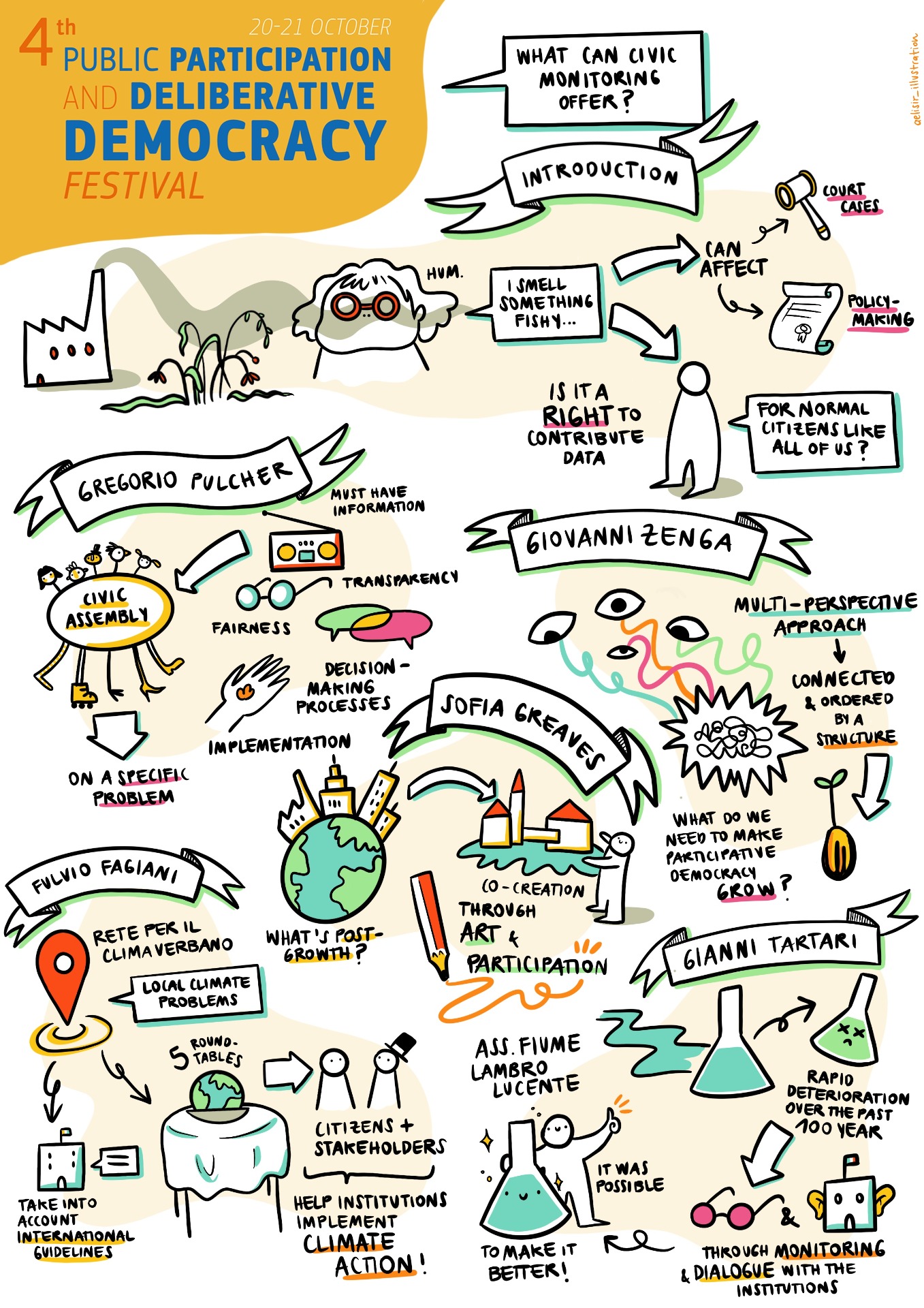
At the convergence of civic monitoring and democracy
SensJus participated in the 4th Public Participation and Deliberative Democracy Festival that took place on 20-21 October 2022, organised by the European Commission's Competence Centre on Participatory and Deliberative Democracy. On the first festival day, we convened a session titled 'What can civic monitoring offer to deliberative democracy?' in Ispra and virtual. We invited speakers from different backgrounds, both academic (University of Vigo, PostGrowth Lab; Politecnico of Milan, Design Lab) and civic (the Observatory for the Lambro River, the Italian Observatory of the Civic Assemblies and the Rete Clima Verbano, Network for the Climate of the Verbano area). We have been accompanied by an illustrator capturing our discussion in live drawings as the figures show. After pitches to the audience from the guest speakers, we had an enriching discussion session with an engaged audience.
We focused on a specific phenomenon of deliberative democracy, known as 'citizens' assemblies'. These are structures and processes through which a representative and stratified sample of ordinary people selected by sortition make political decisions on matters of public interest. We discussed how bring the reality of citizens' assemblies closer to that of 'civic (environmental) monitoring'. The latter is a social phenomenon in which ordinary people collect data on the state of the environment and/or their health in relation to the environment. Civic monitoring can also apply to other issues such as public funds' expenditure. We posited that the two forms of participation, i.e., citizen assemblies and civic monitoring, could have a complementary value, which might help address some of the respective limitations. The selection by sortition of participants of citizens' assemblies could address the representativeness limitations of civic monitoring. In addition, recommendations and decisions by citizens' assemblies can be recognized a legally binding value, i.e. they will then be implemented by the authorities. This is a characteristic that the results of civic monitoring mostly do not have, as there is no obligation by authorities to consider them. Civic monitoring, in our view, could provide valuable evidence to citizens' assemblies, turning participation capable of pervading not only the discussion and decision-making stage, but also the crucial participants' training stage. At this stage, inviting people that engaged with civic monitoring on the issue at discussion could complement the material on which participants will decide. In this case, civic monitoring could intervene 'upstream' of the assembly. We believe that this sharing of a broadened pool of evidence on a given matter could lead to more legitimized results. In addition, the discussions that take place within the citizens' assemblies could also stimulate more civic monitoring. In this instance, civic monitoring could occur 'downstream' of the citizens' assembly. Lastly, the implementation of recommendations from the assembly could be monitored through a civic monitoring approach. This could enhance the skills and knowledge gained by participants, and the trust in the fact that decisions stemming from the assembly will be concretely implemented.

In addition to this convergence, we also discussed other three overarching threads:
- A first thread is that of focusing on shared responsibilities in designing participatory processes rather than on claiming own rights. This approach seems also more in line with the idea of embracing a multi-level governance of shared challenges. In addition, more and more we see the emersion of a 'glocal' approach. This approach is exemplified by the coordinated response to global and local emergencies through very situated solutions (such as of the Climate Civic Tables supporting municipalities that signed the 'Climate Emergency Declaration').
- Another thread revolved around distrust towards institutions, towards 'fake' or apparent (just performative) forms of civic engagement. We also discussed the role of research institutions like the JRC to mediate in the complex spaces between institutions and civic actors, for example validating the civic data in the eyes of institutions and vice versa, extract the information produced in reliable ways, create bridges among stakeholders. There is still an open question, which is how can participatory instances reach those people that lost faith in democracy. A way forward could be to go where people are, embrace existing initiatives launched by these people, and seek to re-establish trust bonds. Art could also be an instrument of mediation to reconnect with people that are disenchanted towards participatory processes, as a recent JRC science for policy brief demonstrates. Art can also help collectively refine questions of inquiry, bring experts closer to civil society and help them have a better understanding of a situated reality. Lastly, we think art can also break or shift hierarchies, enabling actors to take up new roles.
- Lastly, a thread embraced the question on which values should be considered in shaping existing and new participatory initiatives. We deem that art can help in illustrating in an emphatic way the different values at stake in a certain process. Also the science behind what people are invited to participate upon matters, which is why scientific issues should be illustrated in a understandable and empathic way to the public, including through artistic forms of expression. Technology in this space can facilitate interactions with remote publics and enhance the analytical and dissemination capacity of the civil society, as the experience of existing civic observatories demonstrates. Yet, we need to jointly decide what is the technology that we want. Here, we could get inspiration for existing technology metrics that question whether technology creates 'relatedness' (does it create community and open up new relations?), is accessible and inclusive (i.e., 'inclusivity by design'), is appropriate to a setting and to a situated community, is adaptable to different settings etc. Lastly, technology-based communication channels and especially social media can help participatory instances to trigger 'chains of involvement' allowing enthusiastic participants to spread the word and reach new publics.
Ways ahead will include pilot experiences of convergence between civic assemblies and civic monitoring, starting from closer realities; emphasis and work on artistic contributions to the field; and a scientific contribution to the Journal of Deliberative Democracy.
